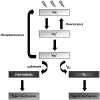Photodynamic inactivation of mammalian viruses and bacteriophages
- PMID: 22852040
- PMCID: PMC3407894
- DOI: 10.3390/v4071034
Photodynamic inactivation of mammalian viruses and bacteriophages
Abstract
Photodynamic inactivation (PDI) has been used to inactivate microorganisms through the use of photosensitizers. The inactivation of mammalian viruses and bacteriophages by photosensitization has been applied with success since the first decades of the last century. Due to the fact that mammalian viruses are known to pose a threat to public health and that bacteriophages are frequently used as models of mammalian viruses, it is important to know and understand the mechanisms and photodynamic procedures involved in their photoinactivation. The aim of this review is to (i) summarize the main approaches developed until now for the photodynamic inactivation of bacteriophages and mammalian viruses and, (ii) discuss and compare the present state of the art of mammalian viruses PDI with phage photoinactivation, with special focus on the most relevant mechanisms, molecular targets and factors affecting the viral inactivation process.
Keywords: bacteriophages; mammalian viruses; photodynamic therapy; photosensitizer; viral photoinactivation process.
Figures




Similar articles
-
Sewage bacteriophage photoinactivation by cationic porphyrins: a study of charge effect.Photochem Photobiol Sci. 2008 Apr;7(4):415-22. doi: 10.1039/b712749a. Epub 2008 Feb 14. Photochem Photobiol Sci. 2008. PMID: 18385883
-
Evaluation of resistance development and viability recovery by a non-enveloped virus after repeated cycles of aPDT.Antiviral Res. 2011 Sep;91(3):278-82. doi: 10.1016/j.antiviral.2011.06.007. Epub 2011 Jun 21. Antiviral Res. 2011. PMID: 21722673
-
Photosensitizers mediated photodynamic inactivation against virus particles.Mini Rev Med Chem. 2015;15(6):503-21. doi: 10.2174/1389557515666150415151505. Mini Rev Med Chem. 2015. PMID: 25877599 Review.
-
Involvement of type I and type II mechanisms on the photoinactivation of non-enveloped DNA and RNA bacteriophages.J Photochem Photobiol B. 2013 Mar 5;120:10-6. doi: 10.1016/j.jphotobiol.2013.01.005. Epub 2013 Jan 20. J Photochem Photobiol B. 2013. PMID: 23416708
-
Trends and targets in antiviral phototherapy.Photochem Photobiol Sci. 2019 Nov 1;18(11):2565-2612. doi: 10.1039/c9pp00211a. Epub 2019 Aug 9. Photochem Photobiol Sci. 2019. PMID: 31397467 Review.
Cited by
-
Robust antimicrobial photodynamic therapy with curcumin-poly (lactic-co-glycolic acid) nanoparticles against COVID-19: A preliminary in vitro study in Vero cell line as a model.Photodiagnosis Photodyn Ther. 2021 Jun;34:102286. doi: 10.1016/j.pdpdt.2021.102286. Epub 2021 Apr 7. Photodiagnosis Photodyn Ther. 2021. PMID: 33838311 Free PMC article.
-
The Application of Porphyrins and Their Analogues for Inactivation of Viruses.Molecules. 2020 Sep 23;25(19):4368. doi: 10.3390/molecules25194368. Molecules. 2020. PMID: 32977525 Free PMC article. Review.
-
Antimicrobial photodynamic therapy with decacationic monoadducts and bisadducts of [70]fullerene: in vitro and in vivo studies.Nanomedicine (Lond). 2014 Feb;9(2):253-66. doi: 10.2217/nnm.13.22. Epub 2013 Jun 5. Nanomedicine (Lond). 2014. PMID: 23738632 Free PMC article.
-
A Novel Approach of Combining Methylene Blue Photodynamic Inactivation, Photobiomodulation and Oral Ingested Methylene Blue in COVID-19 Management: A Pilot Clinical Study with 12-Month Follow-Up.Antioxidants (Basel). 2022 Nov 8;11(11):2211. doi: 10.3390/antiox11112211. Antioxidants (Basel). 2022. PMID: 36358582 Free PMC article.
-
Oxygen-dependent laser inactivation of murine norovirus using visible light lasers.Virol J. 2018 Jul 31;15(1):117. doi: 10.1186/s12985-018-1019-2. Virol J. 2018. PMID: 30064439 Free PMC article.
References
Publication types
MeSH terms
Substances
LinkOut - more resources
Full Text Sources
Other Literature Sources
Medical

